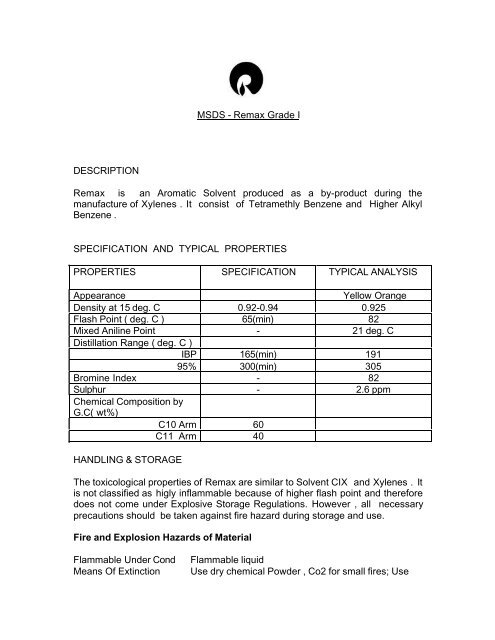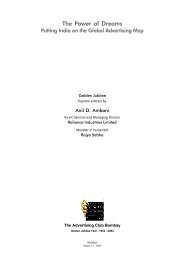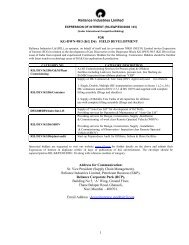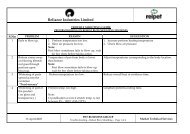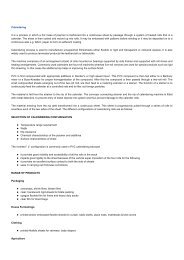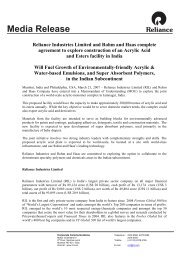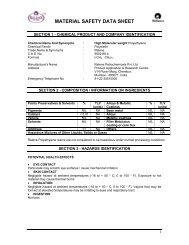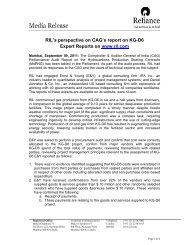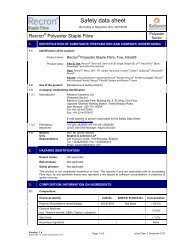MSDS - Remax Grade I DESCRIPTION Remax is an Aromatic ...
MSDS - Remax Grade I DESCRIPTION Remax is an Aromatic ...
MSDS - Remax Grade I DESCRIPTION Remax is an Aromatic ...
Create successful ePaper yourself
Turn your PDF publications into a flip-book with our unique Google optimized e-Paper software.
<strong>MSDS</strong> - <strong>Remax</strong> <strong>Grade</strong> I<br />
<strong>DESCRIPTION</strong><br />
<strong>Remax</strong> <strong>is</strong> <strong>an</strong> <strong>Aromatic</strong> Solvent produced as a by-product during the<br />
m<strong>an</strong>ufacture of Xylenes . It cons<strong>is</strong>t of Tetramethly Benzene <strong>an</strong>d Higher Alkyl<br />
Benzene .<br />
SPECIFICATION AND TYPICAL PROPERTIES<br />
PROPERTIES SPECIFICATION TYPICAL ANALYSIS<br />
Appear<strong>an</strong>ce Yellow Or<strong>an</strong>ge<br />
Density at 15 deg. C 0.92-0.94 0.925<br />
Flash Point ( deg. C ) 65(min) 82<br />
Mixed Aniline Point - 21 deg. C<br />
D<strong>is</strong>tillation R<strong>an</strong>ge ( deg. C )<br />
IBP 165(min) 191<br />
95% 300(min) 305<br />
Bromine Index - 82<br />
Sulphur - 2.6 ppm<br />
Chemical Composition by<br />
G.C( wt%)<br />
C10 Arm 60<br />
C11 Arm 40<br />
HANDLING & STORAGE<br />
The toxicological properties of <strong>Remax</strong> are similar to Solvent CIX <strong>an</strong>d Xylenes . It<br />
<strong>is</strong> not classified as higly inflammable because of higher flash point <strong>an</strong>d therefore<br />
does not come under Explosive Storage Regulations. However , all necessary<br />
precautions should be taken against fire hazard during storage <strong>an</strong>d use.<br />
Fire <strong>an</strong>d Explosion Hazards of Material<br />
Flammable Under Cond<br />
Me<strong>an</strong>s Of Extinction<br />
Flammable liquid<br />
Use dry chemical Powder , Co2 for small fires; Use
ordinary foam for large ones<br />
Special Procedure -<br />
Explosion Data Stable<br />
Sensitivity to Chemical<br />
Impact<br />
Sensitivity to stsstic c<strong>an</strong> develop static charge due to flow.<br />
D<strong>is</strong>charge<br />
Reactivity Data<br />
Stability Under Cond<br />
Incompatibility to Other Subst<strong>an</strong>ces<br />
Under following Conditions<br />
Reactivity Under Following Condition<br />
Hazardous Products Of Decomposition<br />
Remarks<br />
Stable<br />
Reacts vigorously with most oxid<strong>is</strong>ing<br />
materials.<br />
reacts with strong nitric acid or<br />
dichlorohydr<strong>an</strong>toin with explosive force.<br />
Acrid smoke but none other reported<br />
---------------------------------------------------------------------------------------------------------<br />
Toxicological Properties Of Material<br />
Route Of Entry<br />
: Inhalation , Ingestion. Skin <strong>an</strong>d Eyes<br />
Effect Of Acute Exposure to material<br />
Contact with eye Irritating to eyes.<br />
Contact With skin C<strong>an</strong> be absorbed through skin , Causes drying of skin<br />
Inhalation<br />
Causes depression of CNS with headache <strong>an</strong>d<br />
dizziness. Irritation of nose <strong>an</strong>d throat; high<br />
concentration c<strong>an</strong> lead to incoordination /<br />
unconsciousness. D<strong>is</strong>orders like lose of memory<br />
(revesible) has been reported.<br />
Ingestion<br />
Reversible effects like liver impairment / pulmonary<br />
edema <strong>an</strong>d in extreme case have been reported on<br />
ingesting .<br />
Effect of Chronic Data <strong>is</strong> not available. However impairment of liver<br />
Exposure to Material functions, decreased platelet counts have been<br />
reported.<br />
Irrit<strong>an</strong>cy of material Irrit<strong>an</strong>t to skin<br />
Irrit<strong>an</strong>cy to ENT Irrit<strong>an</strong>t to eyes<br />
Sensit<strong>is</strong>ation<br />
Data not available<br />
Carcinigenicity Data not available<br />
Teratogenicity -
Mutagenicity<br />
Data not available<br />
Synerg<strong>is</strong>tic Material -<br />
Preventive Measures<br />
H<strong>an</strong>d Protection<br />
Respiration<br />
Eye<br />
Footwear<br />
Clothing<br />
Other<br />
Engineering Control<br />
Leak & Spill<br />
Containment Procedure<br />
recommended<br />
Waste d<strong>is</strong>posal<br />
Procedure<br />
recommended<br />
H<strong>an</strong>dling Procedure &<br />
Equipment<br />
Storage requirement<br />
Special shipping<br />
Information<br />
Viton or PVA gloves suitable for preventing skin<br />
contact.<br />
Use breathing apparatus; Hydrocarbon adsorbing<br />
c<strong>an</strong><strong>is</strong>ters.<br />
Use chemical goggles<br />
Gumboots to prevent skin contact<br />
Avoid skin contact; PVA aprons.<br />
Contain leaking liquid on s<strong>an</strong>d or earth. Absorb small<br />
spills with absorbent. Wash the surface with water <strong>an</strong>d<br />
soap.<br />
Seal the waste in vapour tight bags for eventual<br />
d<strong>is</strong>posal; Incinerate.<br />
Avoid sparks, open flame <strong>an</strong>d oxidizing materials while<br />
h<strong>an</strong>dling .<br />
Store in well ventilated, cool dry place away from<br />
direct sunlight, Avoid proximity to oxidizing agents.<br />
-<br />
---------------------------------------------------------------------------------------------------------<br />
First Aid Measures<br />
Contact With Eye Wash with water with eyelids held open for at least 20<br />
minutes. Get medical help.<br />
Contact With Skin Wash with water. Seek medical help.<br />
Inhalation<br />
Remove victim to fresh air. Give artificial respiration if<br />
required.<br />
Ingestion<br />
Do not induce vomiting. If convusions are not present<br />
then give a glass of water to dilute the ingested<br />
material.


